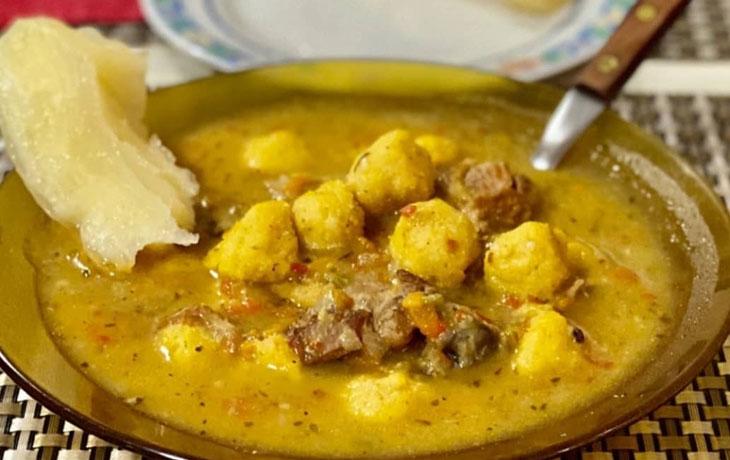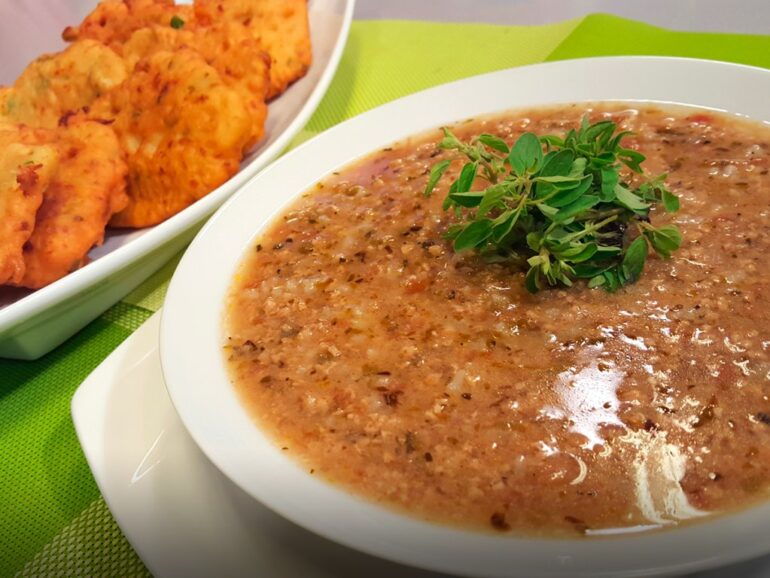The winter season has arrived in Paraguay and at this time of the year, people miss dishes that not only warm their cold bodies, but also their souls. Although Paraguay is known for its hot weather, where the summer can get to around 38°C (100°F), there are a lot of traditional dishes that are made to eat during the cold season. In this article, we introduce some traditional Paraguayan dishes that you should definitely try on a cold day.
Patel Mandi’o or Empanada de Mandioca (Non-vegetarian)
Pastel Mandi’o is a Paraguayan traditional meat pie, the outer skin is made of tapioca and is very chunky. The inside is wrapped with beef, egg, and sometimes vegetables, and is very juicy! It is often available at any Empanada specialty stores, but only during winter. When the cold season arrives in Paraguay, it is a typical dish that the locals all come to eat.
Chipa Asador or Chipa Kavure (Vegetarian)
Chipa, Paraguay’s most famous cheese bread, comes in many varieties, one of them is Chipa Kavure or Chipa Asador. This, as the name suggests, is cooked directly over the fire using a stick, just like asado, so that’s why is called ‘Chipa Asador’. This type of chipa is not easy to find anywhere and mostly is only sold during San Juan Ara (a traditional Paraguayan festival held on June 24).
Mbeju (Vegetarian)
Mbeju is a traditional Paraguayan tapioca pancake. It is made from a mixture of cassava flour, cheese, and butter. It is crispy on the outside and chewy on the inside. The saltiness of the cheese and the slight sweetness of the cassava are perfectly balanced, making it a perfect snack or breakfast on cold days. They are very easy to prepare at home, but you can also find them in cafeterias. It is popular to eat with coffee or ‘cocido’, a Paraguayan tea.
Cocido (Vegetarian/Vegan)
The drink that goes well to accompany with all the above snacks, is Cocido. This is a drink made from roasted yerba mate. Yerba Mate is a mix of tea leaves widely consumed in South America and is also popular in Paraguay as a cold drink called ‘terere’. However, during the cold season, locals roast the yerba mate using charcoal which makes it a very flavorful drink. You can drink it by adding hot water and sugar or milk is optional. Some people may find out that this is Paraguay’s version of Coffee!
Mate Tea (Vegan)
Another tea commonly consumed in winter is Mate. It is traditionally drunk in many Latin American countries and is a favorite of Paraguayans during the cold season. Mate in Paraguay has used the same yerba as ‘terere’, but with hot water instead of cold. Winter in Paraguay is the season of citric fruits, so some people like to add slices of orange or lemon into the hot water to make it more flavorful.
Vori Vori or Bori bori (Non-vegetarian)

Vori vori, also known as bori bori, is one of the most popular and traditional soups in Paraguayan cuisine. It is prepared with chicken, corn dumplings, Paraguayan cheese and is rich in vegetables. The salty and thick yellow chicken soup warms the body during the cold weather.
The word ‘vori’ comes from Spanish meaning ‘little ball’, and this word changed to bori or vori over time. In Guarani the repetition of the same word represents the richness of the same. Thus, repeating ‘Vori vori’ means the abundance of corn dumplings.
Soyo con Tortilla (Non-vegetarian)
Soyo is a very simple traditional Paraguayan soup. It is made with ground beef and plenty of vegetables. It is usually accompanied with Tortilla which is a fried tempura of cheese or vegetables. The word soyo is a corruption of ‘So’o josopy’ from the Guarani language, consisting of two words: ‘so’o’ meaning meat and ‘josopy’ meaning crushed. This refers to the minced meat from which the soup is made.
Dulce batata con queso Paraguay (Vegetarian)
Finally, Paraguay has a very traditional dessert that is eaten with Paraguayan cheese. Dulce de batata is a Paraguayan jam made from sweet potato, although it is called ‘dulce’ which means jam, this is solid. This dessert is widely consumed in Latin America, but what gives it its traditional Paraguayan flavor is the Paraguayan cheese that is served with the jam.
Paraguayan gastronomy is based on a mixture of Spanish and Guarani cultures. The Guarani people’s cuisine is said to have been based on maize and yuca or mandica. Previously, they did not eat meat, milk or cheese. This was introduced by the Spanish people. Today, most of the Paraguayan cuisine is inherited from this Guarani custom. The Paraguayan winter is short, so don’t miss this opportunity to try and fully enjoy typical Paraguayan winter dishes!


